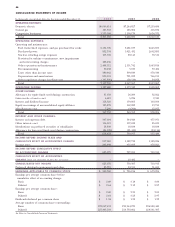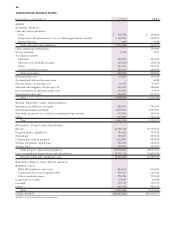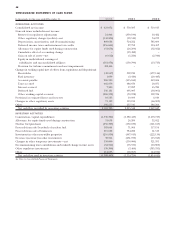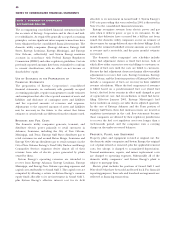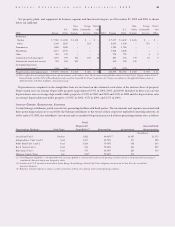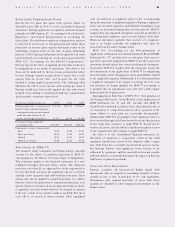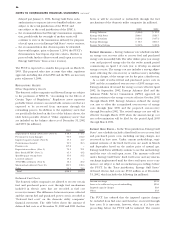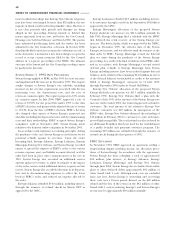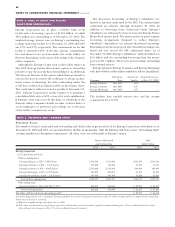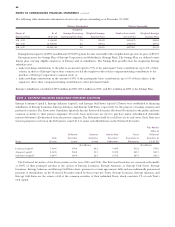Entergy 2002 Annual Report Download - page 56
Download and view the complete annual report
Please find page 56 of the 2002 Entergy annual report below. You can navigate through the pages in the report by either clicking on the pages listed below, or by using the keyword search tool below to find specific information within the annual report.
INVESTMENTS
Entergy applies the provisions of SFAS 115, “Accounting for
Investments for Certain Debt and Equity Securities,” in
accounting for investments in decommissioning trust funds.
As a result, Entergy records the decommissioning trust funds
at their fair value on the consolidated balance sheet. As of
December 31, 2002 and 2001, the fair value of the securities
held in such funds differs from the amounts deposited plus
the earnings on the deposits by ($24) million and $93 million,
respectively. In accordance with the regulatory treatment for
decommissioning trust funds, the domestic utility companies
have recorded an offsetting amount of unrealized gains/(losses)
on investment securities in accumulated depreciation. For the
nonregulated portion of River Bend, Entergy Gulf States has
recorded an offsetting amount of unrealized gains/(losses) in
other deferred credits. System Energy’s offsetting amount of
unrealized gains/(losses) on investment securities is in other
regulatory liabilities.
Decommissioning trust funds for Pilgrim, Indian Point 2, and
Vermont Yankee do not receive regulatory treatment.
Accordingly, unrealized gains and losses recorded on the assets
in these trust funds are recognized as a separate component of
shareholders’ equity because these assets are classified as
available for sale.
EQUITY METHOD INVESTEES
Entergy owns investments that are accounted for under the
equity method of accounting because Entergy’s ownership level
results in significant influence, but not control, over the
investee and its operations. Entergy records its share of earnings
or losses of the investee based on the change during the period
in the estimated liquidation value of the investment, assuming
that the investee’s assets were to be liquidated at book value.
Entergy discontinues the recognition of losses on equity
investments when its share of losses equals or exceeds its
carrying amount of investee plus any advances made or
commitments to provide additional financial support. See
Note 13 to the consolidated financial statements for additional
information regarding Entergy’s equity method investments.
DERIVATIVE FINANCIAL INSTRUMENTS AND
COMMODITY DERIVATIVES
Entergy implemented SFAS 133, “Accounting for Derivative
Instruments and Hedging Activities” on January 1, 2001. The
statement requires that all derivatives be recognized in the
balance sheet, either as assets or liabilities, at fair value. The
changes in the fair value of derivatives are recorded each
period in current earnings or other comprehensive income,
depending on whether a derivative is designated as part of a
hedge transaction and, if it is, the type of hedge transaction.
For cash-flow hedge transactions in which Entergy is hedging
the variability of cash flows related to a variable-rate asset,
liability, or forecasted transaction, changes in the fair value of
the derivative instrument are reported in other comprehensive
income. The gains and losses on the derivative instrument that
are reported in other comprehensive income are reclassified as
earnings in the periods in which earnings are impacted by the
variability of the cash flows of the hedged item. The ineffective
portions of all hedges are recognized in current-period earnings.
Contracts for commodities that will be delivered in quantities
expected to be used or sold in the ordinary course of business,
including certain purchases and sales of power and fuel, are not
classified as derivatives. Revenues and expenses from these
contracts are reported on a gross basis in the appropriate
revenue and expense categories as the commodities are
received or delivered.
Effective January 1, 2001, Entergy recorded a net-of-tax cumu-
lative-effect-type adjustment of approximately $18.0 million
reducing accumulated other comprehensive income to
recognize, at fair value, all derivative instruments that are
designated as cash-flow hedging instruments, primarily interest
rate swaps and foreign currency forward contracts related to
Entergy’s competitive businesses. Effective October 1, 2001,
Entergy recorded an additional net-of-tax cumulative-effect-
type adjustment that increased net income by approximately
$23.5 million. This adjustment resulted from the implementa-
tion of an interpretation of SFAS 133 that requires fuel supply
agreements with volumetric optionality to be classified as deriva-
tive instruments. The agreement that resulted in the adjustment
is in the Energy Commodity Services segment and was disposed
of in the Damhead Creek sale in December 2002.
IMPAIRMENT OF LONG-LIVED ASSETS
Entergy periodically reviews long-lived assets held in all of its
business segments whenever events or changes in circumstances
indicate that recoverability of these assets is uncertain.
Generally, the determination of recoverability is based on the
undiscounted net cash flows expected to result from such
operations and assets. Projected net cash flows depend on the
future operating costs associated with the assets, the efficiency
and availability of the assets and generating units, and the future
market and price for energy over the remaining life of the
assets. See Note 12 to the consolidated financial statements for
discussion of current year asset impairments in the Energy
Commodity Services segment.
RIVER BEND AFUDC
The River Bend AFUDC gross-up represents the incremental
difference imputed by the Louisiana Public Service
Commission (LPSC) between the AFUDC actually recorded by
Entergy Gulf States on a net-of-tax basis during the construc-
tion of River Bend and what the AFUDC would have been on
a pre-tax basis. The imputed amount was only calculated on
that portion of River Bend that the LPSC allowed in rate base
and is being amortized over the estimated remaining economic
life of River Bend.
54
NOTES TO CONSOLIDATED FINANCIAL STATEMENTS continued


